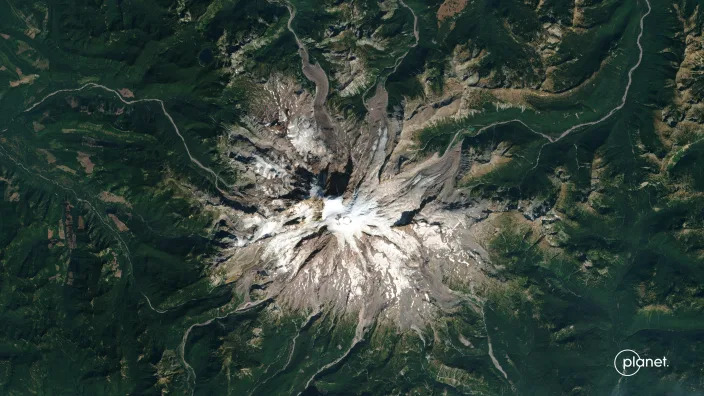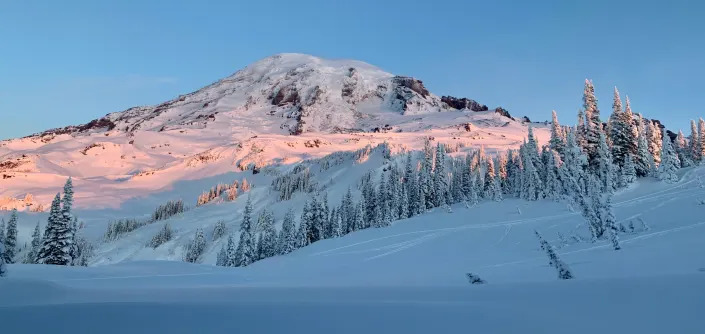Evan Bush
Thu, June 22, 2023
A warming climate has melted three glaciers on Mount Rainier, the tallest volcano in the lower 48 states — more evidence of the rapid worldwide decline of mountain ice.
The total mass of glacier ice on Mount Rainier, southeast of Seattle, is less than half what it was in 1896, according to estimates from a National Park Service report published this month. Among its more than two dozen glaciers, the mountain is likely to have lost an area of glacial ice that’s nearly the size of Manhattan. The pace of its losses is picking up, the report found.
“We’re getting to a tipping point on some of the south-facing glaciers. We’re reaching points where there’s really not a lot of ice to be lost,” said an author of the report, Scott Beason, a geologist at Mount Rainier National Park. “The area change is accelerating in the last six years. That’s kind of a big, scary thing.”
Mount Rainier’s glaciers are flowing rivers of ice at the headwater of five major watersheds in the Pacific Northwest. They provide drinking water downstream, feed mountain streams with cold water for salmon and spin hydropower turbines to generate electricity in the Northwest.
Glaciers across the world are on a path of prolonged decline, a trend driven by the human use of fossil fuels and the accumulation of heat-trapping gasses in the atmosphere, according to scientists who contributed to the United Nations Intergovernmental Panel on Climate Change. The near-simultaneous and ongoing retreat of nearly all of the world’s glaciers is unprecedented in at least the past 2,000 years, the panel found. The melting of glaciers is responsible for more than a fifth of global sea level rise.

Mount Rainier on Sept. 27, 2022. (Planet Labs PBC)
Declines in the ice stored around Rainier’s cap could reduce habitat for fish like bull trout, which the U.S. Fish & Wildlife Service categorizes as a threatened species. The retreat of glaciers has already caused structures at Camp Muir, a camp for climbers, to shift slightly as the ground destabilizes, Beason said. Further declines could cause more debris flows and landslides as the retreat of glaciers reshapes the park’s landscape.
“It’s going to turn into a darker-looking mountain,” Beason said. “Everything is going to look different in the next century because of this. It will be interesting to see how we adapt.”
Mountain glaciers are a water source for nearly 2 billion people. A study published this year in the journal Science predicts mountain glaciers will lose 26% to 41% percent of their mass, as measured in 2015, by the end of this century depending on how much more the Earth warms.
Mount Rainier is the most glaciated peak in the lower 48 states, and its slopes contain more ice than all of the glaciers that blanket the rest of the peaks in Cascade Range mountains combined, Beason said.
The mountain’s summit is about 60 miles from Seattle, and it dominates the city’s skyline on clear days. It draws more than 2 million visitors every year. For much of the year, its glaciers are blanketed in fresh snow. Glacier ice is exposed in the summer as the snow melts away.
The park’s glaciers — defined as moving bodies of ice that persist — have been mapped for 125 years, with a first inventory completed in 1896, according to the report on Mount Rainier’s glaciers, which summarized centuries of research on the extent of glaciers in the national park.
The report, which listed 28 glaciers for 2021, found their mass decreased by nearly 52% since 1896. The area of Mount Rainier covered by glaciers fell from nearly 50 square miles to just more than 29 square miles — a nearly 42% decline.
The National Park Service officially removed the Stevens Glacier from its inventory because it had grown too small and there was a lack of evidence that ice was flowing, such as crevassing.
The report said two other glaciers — the Pyramid and Van Trump glaciers — lost 34% and 43% of their volume from 2015 to 2021. Park researchers concluded they were “in serious peril.”

Mount Rainier in 2020. (Evan Bush / NBC News)
Mauri Pelto, an environmental scientist and professor at Nichols College in Massachusetts who has monitored glaciers in the Cascades since the early 1980s, separately examined more recent satellite data from 2022 and found both the Pyramid and Van Trump glaciers were too fragmented and small to be considered glaciers. He called it a “dramatic change” since 2015.
“There’s just a few ice patches the size of a Little League field,” said Pelto, who considers both to be dead glaciers.
Beason said that the park’s study evaluated conditions only through 2021 but that he didn’t doubt Pelto’s independent assessment.
The melt-out leaves the park with just 26 glaciers. The three dead glaciers join a list of icy features now gone from Mount Rainier, including the Paradise ice caves, which disappeared in the 1980s, and the Williwakas Glacier, which was considered dead in the 1930s.
“We need to be real about what’s happening,” Pelto said. “Let’s not let them slip away and not acknowledge that they’re gone.”
No comments:
Post a Comment